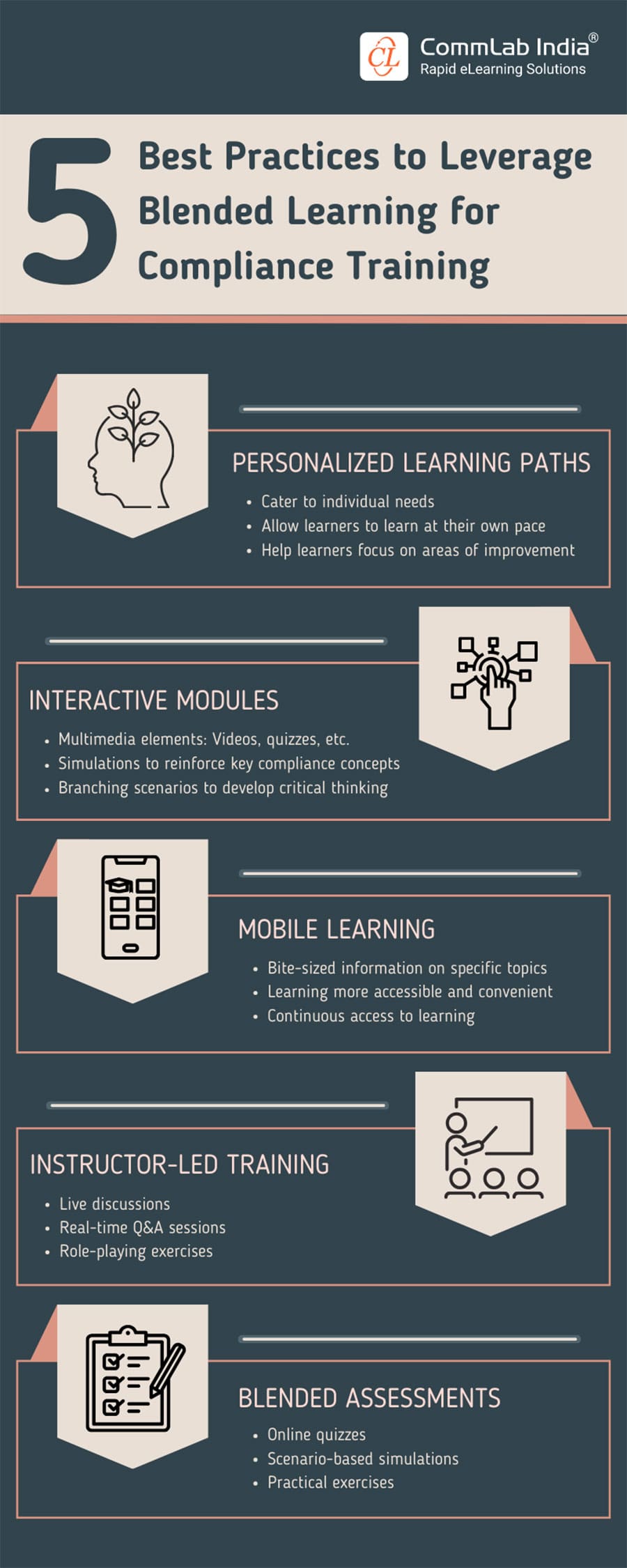How Blended Learning Adds a WOW Factor to Compliance Training [Infographic]
![How Blended Learning Adds a WOW Factor to Compliance Training [Infographic] How Blended Learning Adds a WOW Factor to Compliance Training [Infographic]](https://blog.commlabindia.com/hubfs/blogs/blended-learning-enhance-compliance-training-info.jpg)
Every training endeavor hinges on one pivotal aspect- captivating and motivating learners. And compliance training too shouldn’t be just about ticking off a mandatory training box, it’s should also be an immersive learning journey that leaves learners saying “WOW”. One effective way to make compliance training engaging is by adopting the blended learning approach. By infusing compliance training with a blend of different training formats, your L&D team can transform it into an immersive, engaging, and ultimately effective learning experience.
Effective Compliance Training— What is its Importance?
By providing comprehensive training on relevant laws, regulations, and company policies, organizations equip employees with the knowledge and skills needed to make informed decisions and conduct business ethically. Moreover, effective compliance training fosters a culture of accountability and integrity within the workforce, promoting trust among stakeholders and safeguarding the organization's reputation. Ultimately, investing in robust compliance training programs not only protects the organization from legal and financial consequences but also cultivates a work environment built on transparency, responsibility, and ethical conduct.
How to Make Compliance Training Engaging?
- Use interactive elements like scenarios and simulations
- Apply gamification techniques for motivation
- Incorporate multimedia such as videos and infographics
- Foster social learning
- Offer self-paced learning modules
- Personalize training experiences
- Offer regular feedback and reinforcement
→ Download Now: Is Blended Learning the Right Option for you? [Checklist]
Challenges in Compliance Training—How Blended Learning Can Help?
Challenge 1: Compliance training content is often dry and unengaging, leading to low learner motivation and retention.
Solution: Incorporate engaging formats such as scenarios and simulations. By allowing learners to interact with realistic situations, they become active participants in their learning journey, enhancing engagement and retention.
Challenge 2: Traditional compliance training methods lack interactive elements, making it challenging for learners to apply concepts to real-world scenarios.
Solution: Utilize social learning platforms like discussion boards and online forums to encourage collaboration and knowledge sharing among learners. Additionally, in a blended learning approach, virtual collaboration tools such as bulletin boards and online communities foster interactive experiences where employees can apply compliance concepts in a supportive environment.
Challenge 3: Delivering compliance training to geographically dispersed employees can be challenging, especially with traditional face-to-face methods.
Solution: Leverage performance support systems like mobile applications and knowledge databases which provide on-demand access to training materials, enabling mobile learning for conveniently accessing content anytime, anywhere, thus overcoming accessibility barriers.
Challenge 4: Employees may struggle to find time for lengthy compliance training sessions amidst their busy schedules.
Solution: Implement self-paced learning modules that allow employees to complete training at their own pace, fitting into their busy schedules. Additionally, utilizing microlearning techniques, such as short scenarios and quizzes, enables employees to engage with training in small, digestible chunks, making it easier to find time for learning.
What are the Best Practices to Leverage Blended Learning for Compliance Training?
Your Next Step!
Embracing innovative approaches to compliance training is crucial for modern organizations. By adopting blended learning, organizations can ensure they meet regulatory requirements while also fostering a culture of continuous learning and ethical practices among employees. Still uncertain about adopting blended learning? Consider answering a few questions to dispel any hesitance. Here’s a quick questionnaire to help you get started.





![How Blended Learning Can Spruce Up Your Corporate Training [Video]](https://blog.commlabindia.com/hubfs/Imported_Blog_Media/blended-learning-game-changer-corporate-training-video.jpg)

![Role of AI in Blended Learning for Effective Corporate Training [Infographic]](https://blog.commlabindia.com/hubfs/blended-learning-ai-role-infographic.jpg)